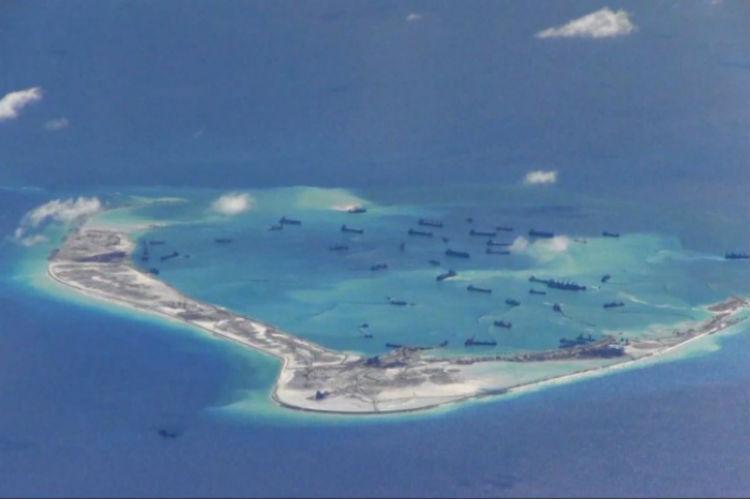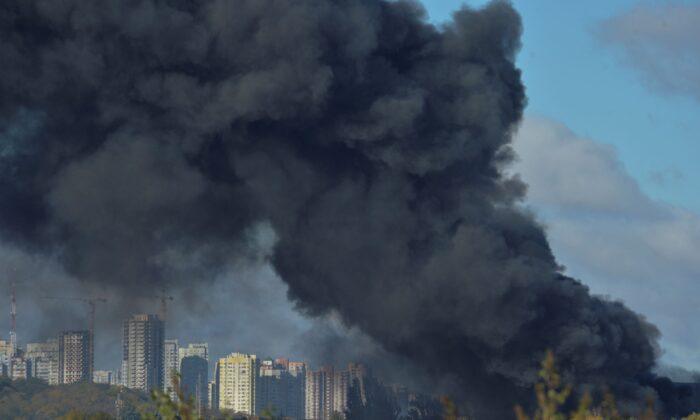Over the last decade the balance of power in the South China Sea (SCS), and to a lesser extent the East China Sea (ECS), has shifted dramatically in favor of China’s military forces.

The United States has a higher proportion of nuclear power surface ships and submarines than does the PLAN. Moreover, in a confrontation with the PLAN, the U.S. Navy would likely be supported by allied nations like Japan and Australia, as well as those of France and Great Britain. Nonetheless, it is clear that Beijing is striving, at the very least, for naval superiority in its home waters and the Western Pacific.
What does the creation of the artificial islands in the SCS, and the rapid expansion of the PLAN do to the U.S. Navy’s ability to project force in the region? For answers and a unique perspective, I recently sat down with former Navy Captain Jim Fanell.
Fanell is currently a government fellow at the Geneva Centre for Security Policy in Switzerland. A former director of Intelligence and Information Operations for the U.S. Pacific Fleet, his near 30-year career as a naval intelligence officer spanned an unprecedented series of afloat and ashore assignments in the Indo-Pacific, specializing in China’s navy and its operations. A recognized international public speaker and accomplished writer, Fanell also is the creator and manager of the Indo-Pacific Security forum Red Star Rising/Risen since 2005.
According to Fanell, the seven islands that China has built in the SCS, and in particular, “the three 10,000-foot runways at Mischief, Fiery Cross, and Subi Reef naval air stations provide the PLA an ability to concentrate forces in the South China Sea (SCS) that would complicate or even deny the U.S. Navy entry into the SCS.”
Fanell noted that the three naval air stations “have more than just the runways and taxiways, they provide hangar space for ordnance loading, refuel and maintenance that can keep the PLANAF [People’s Liberation Army Naval Air Force]/PLAAF [People’s Liberation Army Air Force] in the air longer, thus providing a war fighting sustainment that is much greater than having to fly the 800 nautical miles from a mainland fighter base like Suixi.”
The upshot said Fanell, is that the airstrips “provides the PLA an effective blocking force against any East Coast-based U.S. Navy carrier strike group that would be seeking to enter the SCS via the Malacca Strait and up from Singapore. This permanent forward deployed Chinese force would free up mainland-based forces to focus their attack operations on Taiwan and countering any U.S. Navy carrier operations to the east of Taiwan.”
These islands, especially the Mischief, Fiery Cross, and Subi reefs naval air stations, are critical for China, claimed Fanell, “to implement their counter-intervention strategy in the SCS, as well as offering an off-axis vector of attack on Taiwan from the south … or even from the southeast as they would surely be able to operate over the Philippines in the event of a full-scale PLA invasion of Taiwan.”

China’s artificial islands are surrounded by a host of other islands controlled by other maritime nations in the South China Sea. Most of these islands are not fortified in any meaningful way and have none or only token military forces stationed on them.
When asked if the United States should push to militarize some of these islands in the same way China has done to its artificial islands, Fanell confirmed that “the notion of getting other nations to create their own versions of Mischief, Fiery Cross, or Subi Reef is an interesting proposition and one that should be pursued for the obvious advantages of having a more permanent presence in the SCS.”
He pointed out, however, that “there are two main problems with the idea: 1) access and 2) building and sustainment.”
“Anywhere the U.S. would seek to build or assist building such a military installation is subject to the host nation, the reaction to such an endeavor by the rest of ASEAN and to a much lesser extent, to the inevitable complaints, threats, and intimidation that the PRC [People’s Republic of China] would make” would have to be considered, he noted.
Moreover, he pointed out that “in the case of the Philippines, it seems highly unlikely, as long as President Duterte, or someone associated with him, remains in office.” Even if he and his colleagues were removed from office, however, “there still would have to be a national debate and approval by the people of the Philippines for something like this to go forward.”
He also observed that it “would be hard to justify such spending when all that really would be needed is for the Philippine government to simply allow U.S. military forces to operate more freely from the existing bases and to seek money from the U.S. to upgrade what is already available.”
He did suggest, however, that the only nation that “might be interested in such an endeavor would be Taiwan and their holding at Itu Aba, but again domestic debate and approval would potentially be a limiting factor. Likewise, it is highly likely that the U.S. China Hands community would campaign that such an offer would ‘provoke’ the PRC, just like the China Hands community’s opposition to moving away from the unwritten U.S. policy of ’strategic ambiguity' regarding recognition of Taiwan.”
Despite persistent rumors in the Washington beltway community that the artificial islands are poorly constructed and, specifically, that the air strips could not sustain extended air operations without substantial damage, Fanell does not believe this to be the case, pointing out that “the rumors that the PRC’s seven artificial islands are poorly constructed or that their airfields could not sustain extended air operations are just that—rumors.”
In fact, he pointed out that “the three main naval air stations of Mischief, Fiery Cross, and Subi Reef continue to be militarized and upgraded. PLAN, PLANAF, and PLAAF operations are conducted on a daily basis and there is no evidence to suggest the islands are being degraded by the seas or weather.”
“High-resolution commercial imagery of these island naval air stations shows these are massive islands, the size of Pearl Harbor or the D.C. Beltway, and contain more than just a runway and a pier,” he noted, and also observed that “they are filled with hangars, extensive housing, command and control facilities, bunkering for ammunition and fuel storage.”
Regarding China’s strategy in the South and East China Seas of using an overwhelming force of short- and intermediate-range missiles, some of which may be nuclear armed, plus air and, to a lesser extent, naval power to create area denial zones that would prevent American military forces from approaching the Chinese mainland, operate in the region, or interfere against amphibious operations against Taiwan, Fanell noted the following:
“The use of short-, medium-, intermediate- and long-range ballistic missiles is an essential part of the PLA’s ‘Counter Intervention’ strategy and has grown from just tens of SRBMs 20 years ago to now having thousands of SRBMs, MRBMs, IRBMs, and most importantly from a naval perspective, anti-carrier ballistic missiles or anti-ship ballistic missiles (ASBMs).
“Weapons like the DF-21D and the DF-26, which have been flight tested against a moving target in the SCS in August 2020, present a serious and lethal threat to all American and allied navy big deck warships operating within the first and second island chains.”

He pointed out that U.S. forces are planning to operate in these “zones,” “but do so at great risk and reliance upon counter-targeting technologies to defeat these ASBMs.” This is why he believes “missile defense systems like the Patriot and THAAD are so vitally important and should be deployed along the first island chain and in Taiwan and the Philippines.”
Fanell also pointed out that theater nuclear weapons (TNW) are also “a threat, but there is little known about this capability in the PLA inventory, let alone how they would be employed from a command-and-control perspective.” He added the following:
“We know the CCP [Chinese Communist Party] leadership is very concerned about control over nuclear weapons and that even the PLA Rocket Force still has oversight over the submarine-launched ballistic missiles (SLBMs) that are onboard their ballistic missile submarines (SSBNs) like the Jin-class and follow-on Type 096 SSBNs.
“What is more concerning is the recent revelations of the 350 ICBM silos being built in central and western China as it appears the PRC is conducting a nuclear arms race with the U.S. It is very likely the CCP is rapidly building up their nuclear arsenal in order to blackmail the U.S. and the world into doing nothing in the event of the PLA launching a conventional invasion of Taiwan.”

Of particular concern to Fanell is that the PLAN is venturing further afield from its territorial waters. Fanell pointed out that for “the past decade the PLAN has operated 24/7/365 in the Gulf of Aden … every minute of every day. Those same ships have also gone on to conduct operations, exercises, and port calls across the Mediterranean and into the Baltic.”
The PLAN’s ability to routinely operate in the first and second island chains, he said, “have changed the naval balance of power in the East and South China Sea.” He added the following:
“For about the past decade, they’ve built five warships for every one the U.S. Navy built (at a much cheaper price) and in 2021 they actually commissioned 22 naval combatants compared to just three for the U.S. Navy (two of which are the small Littoral Combat Ship).
“The naval balance of power has dramatically shifted in Asia in the PRC/PLAN’s favor. Not only do they have more ships and submarines in the theater, but they are outbuilding us in tonnage over the last half decade and are putting to sea more supersonic anti-ship cruise missiles (ASCMs) with longer ranges compared to shorter ranges and subsonic U.S. Navy Harpoon ASCMs.”

“We need a national campaign to rebuild the Navy … a new 600-ship Navy,“ he argued, adding that ”the Trump team demonstrated that even with a sclerotic bureaucracy within the Congress and Pentagon, it was possible to arrest the downward trend in U.S. Navy shipbuilding. Imagine what could happen if a true Reagan-like 600-Ship Navy Campaign were to be pursued with a nation unified in its understanding of the existential threat the PRC represents?”
Fanell also dismissed speculation that a Chinese move on Taiwan would be preceded by a preemptive strike against Pratas Island. The island is roughly halfway between the Chinese mainland and Taiwan, and is claimed by both countries. Taiwan has a token military force on the island, but the island’s airspace is under Hong Kong’s air traffic control.
“I am afraid the many defense analysts like to talk about the importance of Pratas Island and make a great deal about the idea that the PLA is planning to take Pratas and then see what Taipei and D.C. would do,” he pointed out.
However, he added, “From all that I’ve read and seen in my career, I do not believe that when the CCP decides to make a full-scale invasion of Taiwan that they will divert time, energy, and resources to attack Pratas Reef, other than possibly launching a few runway penetrating SRBMs.”
When the CCP decides to attack Taiwan, he said, “they are going for the main island and they will seek to decapitate the government in Taipei, neutralize key military forces across the island, and get boots on the ground as soon as possible.”





